
Coral Gemstone: Meaning, Properties, Value & Information
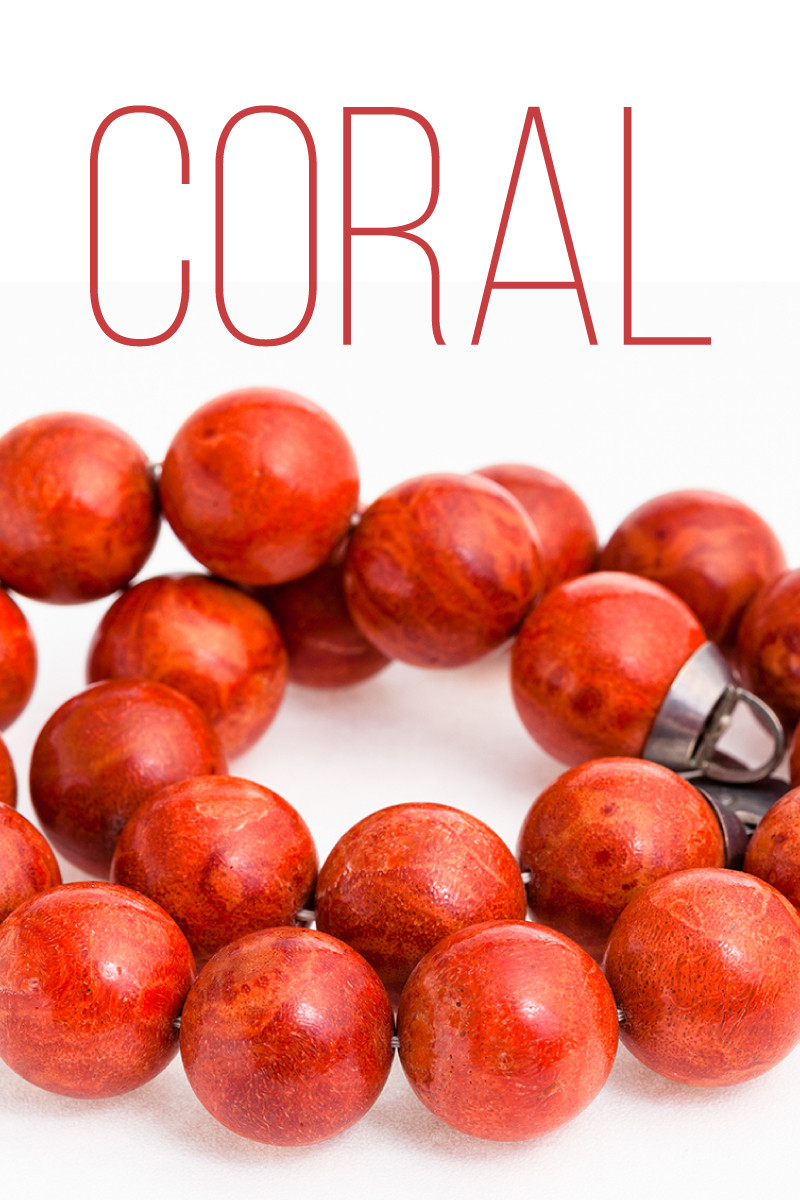 Coral is an organic material that often has vibrant pink, red, or orange coloring. But is coral a gemstone? It is! Coral is an organic gemstone, like pearl or amber, meaning we can thank living organisms (rather than geological processes) for its formation.
Coral is an organic material that often has vibrant pink, red, or orange coloring. But is coral a gemstone? It is! Coral is an organic gemstone, like pearl or amber, meaning we can thank living organisms (rather than geological processes) for its formation.
Biologically, “coral” refers to both a marine animal (coral polyps) and the hard exoskeleton they secrete. Outside of biology, “coral” can refer to the pink-orange color named after the creature and, of course, coral gemstones!
These gemstones are among the oldest in history, with uses going back to prehistoric times. Most coral used in jewelry or decor is called “precious coral.”
In this guide, we’ll teach you the ocean of sea-crets about coral gemstones, including their different colors, uses, prices, and more!
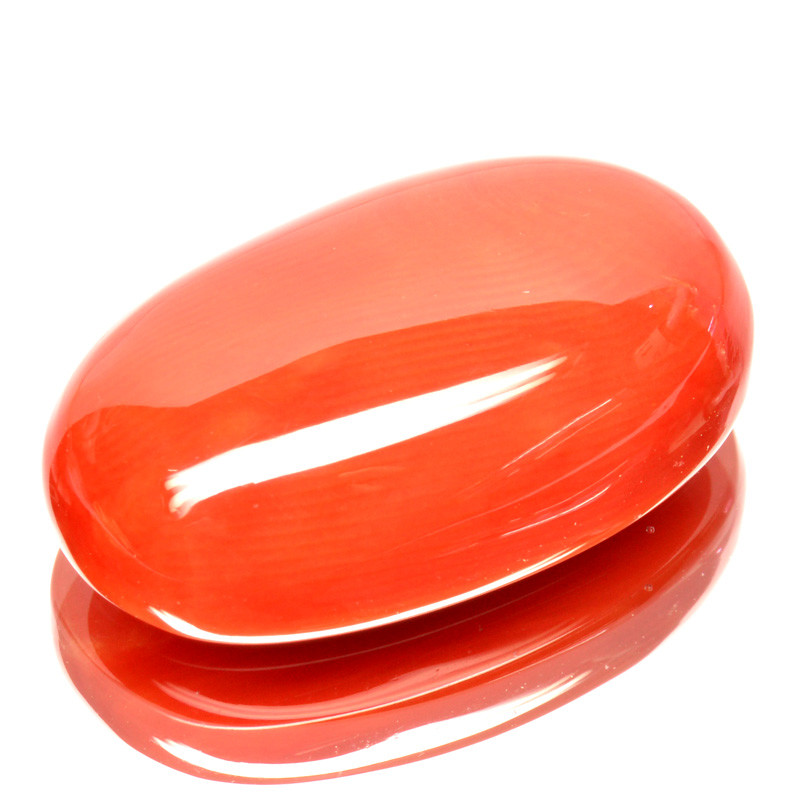
What Is Coral Stone?
Despite the “precious coral” name, coral used for adornment is a semi-precious gemstone. You’ll also see the name “red coral” often, but what is red coral?
Red coral is synonymous with Precious coral, and both refer to species in the Corallidae family used for their durability and vivid colors. When used as a name, the red coral color can actually be red, pink, orange, or a mixture.
Astrologically, coral is a zodiac stone for Aries. In Hindu astrology, red coral (Moonga) is a star stone for Mars and can dampen the effects of a negative Mars placement in your chart.
On the softer side, coral is also a traditional gemstone for the 35th wedding anniversary!
Coral Specifications & Characteristics
First, is coral a mineral? No, coral is a mineraloid, but many are largely composed of minerals — namely, calcite and aragonite (two forms of calcium carbonate).
The calcium carbonate material makes up corals’ exoskeletons in a mesh of interwoven spikes called spicules. Carotenoid pigments in the water color them in red shades.
Initially, the tree-like branches of coral polyps are matte (dull), but polish to a waxy or glass-like luster.
Check out the genuine coral characteristics below:
Mohs hardness: 3-4
Color: White, red, pink, orange, or a mixture (calcareous); Black, blue, golden, or brown (conchiolin)
Crystal structure: None
Luster: Dull, waxy, or vitreous (glass-like)
Transparency: Semi-transparent to opaque
Refractive index: 1.48-1.56 (calcareous); 1.56-1.65 (conchiolin)
Density: 2.6-2.7 (calcareous); 1.30-1.35 (conchiolin)
Cleavage: None
Fracture: Splintery or uneven
Streak: White
Luminescence: Sometimes fluorescence in SW-UV & LW-UV; White coral - light blue; Red, orange, and pink coral - Orange or pink-orange; Dark red coral - Red or burgundy
If you noticed the calcareous and conchiolin specifications in the list above, we’re covering those next!
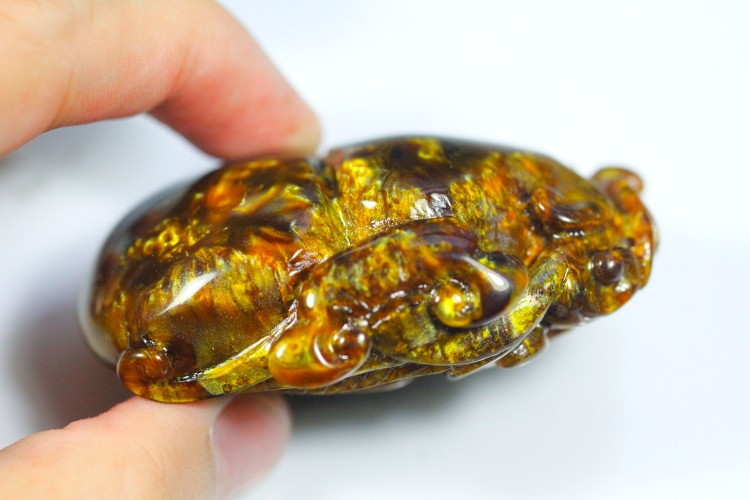 Image: Black conchiolin coral dyed gold and carved
Image: Black conchiolin coral dyed gold and carved
Types of Coral
The coral species has hundreds of varieties, but only some are used as gemstones. There are two umbrellas for coral gemstone varieties: calcareous corals and conchiolin corals.
Calcareous corals, most of the so-called “common corals,” can be shades of red, white, and pink. They’re mostly made up of calcium carbonate. Their waxy structure is full of fibers, along with cavities for the polyps.
The calcareous category includes the types of red coral (precious coral) typically seen in jewelry: Corallium rubrum and Corallium japonicum.
Conchiolin corals, or proteinaceous corals, are the second umbrella with the rarer black, gold, and brown hues. Instead of minerals, the composition of these corals are complex, organic proteins called conchiolin.
These corals have circular patterns resembling tree rings and white semi-circles where their branches meet. The conchiolin category also includes blue coral, a rare variety with blue skeletons!
Compared to calcareous corals, conchiolin corals are more durable but rarer and less vibrant.
Ancient peoples didn’t know all the coral subtypes, but they did assign coral a myriad of meanings and powers.
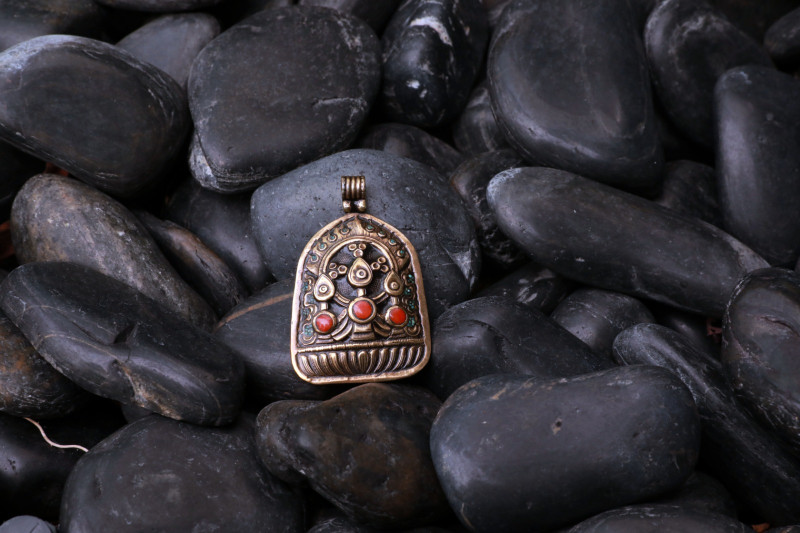 Image: Tibetan brass pendant with coral stone
Image: Tibetan brass pendant with coral stone
Coral Stone Meaning & History
Today, red coral’s meaning is one of joy, humility, and wisdom. But different groups throughout history have assigned sacred meanings and origins to coral.
Mythology & Legends
Ancient Greeks described coral’s origin in the myth of Perseus. According to Ovid’s Metamorphoses, the demi-god Perseus was recovering on a riverbank after defeating the sea monster Cetus.
Having defeated and decapitated the Gorgon Medusa earlier, he placed her head down for a moment. In that time, Medusa’s blood had turned nearby seaweeds (or reeds) red. This led to the Greek term Gorgeia (after Gorgon) for coral.
Ancient Romans used coral to diagnose illnesses, treat poisoning, and protect children. Indigenous Hawaiians used native black coral to heal mouth sores and lung issues.
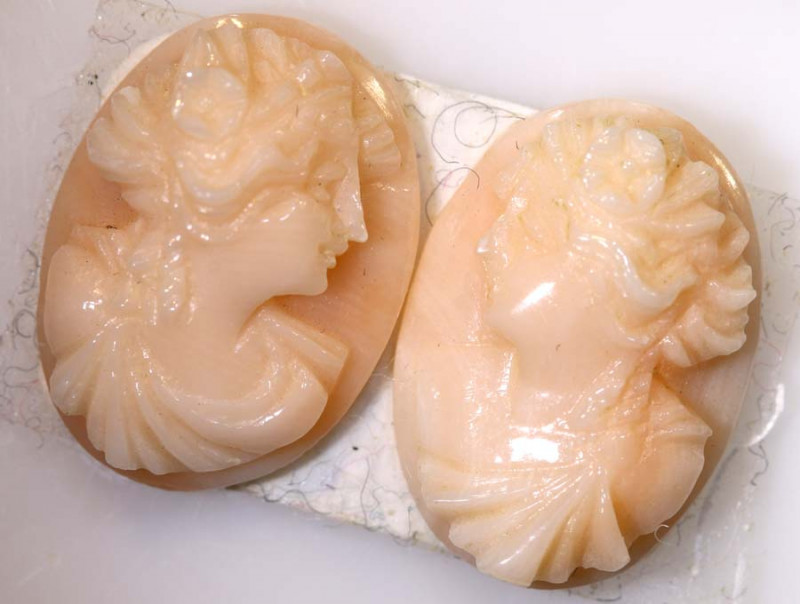
History
The word “coral” likely derives from the Hebrew goral or Arabic ǧaral, both descriptions of the animal that mean “small stone.” Most ancient records or artifacts reference Mediterranean-sourced coral.
Archeological digs have uncovered coral jewelry in Europe dating back to prehistoric times, among ancient coral artifacts sprinkled worldwide.
The earliest known writings on coral come from ancient Greek scholar Theophrastus in his treatise On Stones from 315 BC. Red or white coral jewelry and decor was common among ancient Greeks, Native Americans, Romans, and Egyptians
Other ancient uses included construction materials and nutritional supplements. Folks in landlocked nations often bartered for coral gems. Roman naturalist Pliny the Elder detailed coral trade routes as early as 1 AD.
Religious scripture and art depict red coral as divine, including Islam, Christianity, Judaism, Buddhism, and Hinduism. Leaders of the West African Bini and Yoruba tribes use red coral jewelry to indicate their status.
Throughout the 1700s-1800s, coral saw soaring popularity in Europe. Since the 1800s, scientists have continued discovering different coral species, even as recently as the 1970s!
Sailing to modern times, what healing powers does coral have?

Coral Healing Properties
Some believe organic stones like coral are even more powerful healing stones than other crystals, though many properties overlap. White coral gemstones share similar purifying and transformative properties of white crystals.
Similarly, red gemstones like precious coral evoke confident and courageous energies, making them perfect chakra stones for the sacral chakra!
What about the physical and emotional coral gemstone benefits?
Physical Healing
Physically, coral is said to treat:
Skin problems (e.g. acne, cysts)
Heart diseases
Poor blood circulation
Lethargy
Nutritional deficiency
Some believe wearing coral will protect you from getting hurt.
Emotional Healing
Do you often feel insecure, anxious, or uncertain of yourself? Coral can help by boosting your courage and confidence! Plus, it’s believed to bring inner peace, attract romance, and help release harbored resentment or guilt.
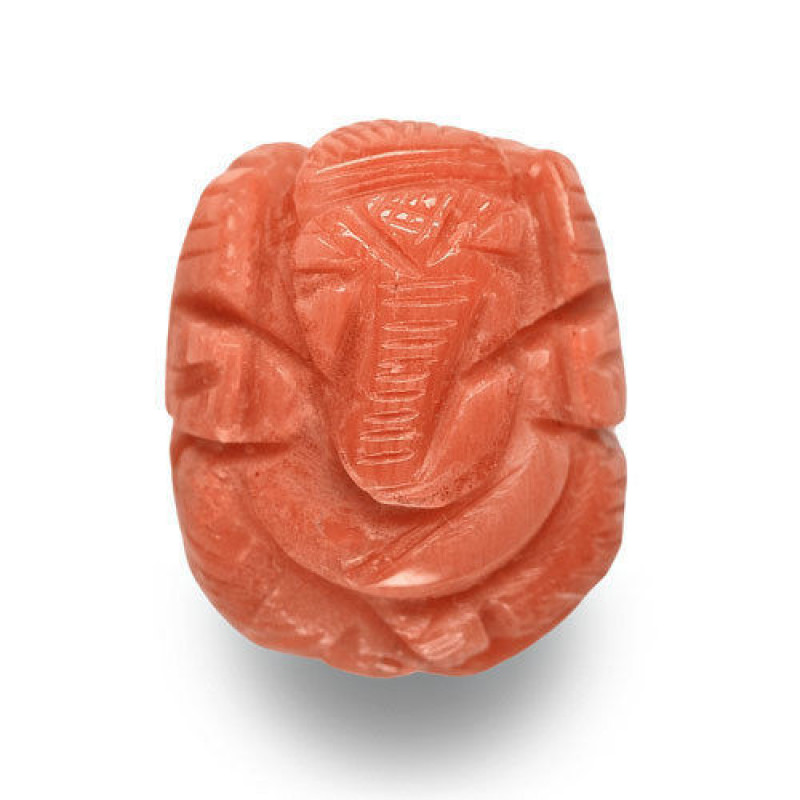
Coral Gemstone Properties
Coral’s objective value comes from many factors, including its rarity and age. The main properties we’ll look at are color, cut, size, and treatments.
Color
White is most common naturally, but coral stone’s color in jewelry is typically pink, red, or orange. However, dyeing makes virtually any color possible. Other natural coral stone colors are blue, brown, yellow, and rarely black or golden. Natural colors come from varying levels of mineral oxidation.
Color-wise, red or pink are the most valuable calcareous coral colors. Orange undertones can slightly lower the value. For conchiolin corals, black, brown, and gold hues are most valuable.
The Corallium rubrum that’s been harvested from the Mediterranean Sea for centuries has a standard-setting color range from pale peachy pink to the most valuable shade: oxblood red.
Though it's not harvested anymore, Hawaiian gold coral is the rarest color. Its hues vary (including tan to near-black) and show more patterns than black or pink coral gemstones.
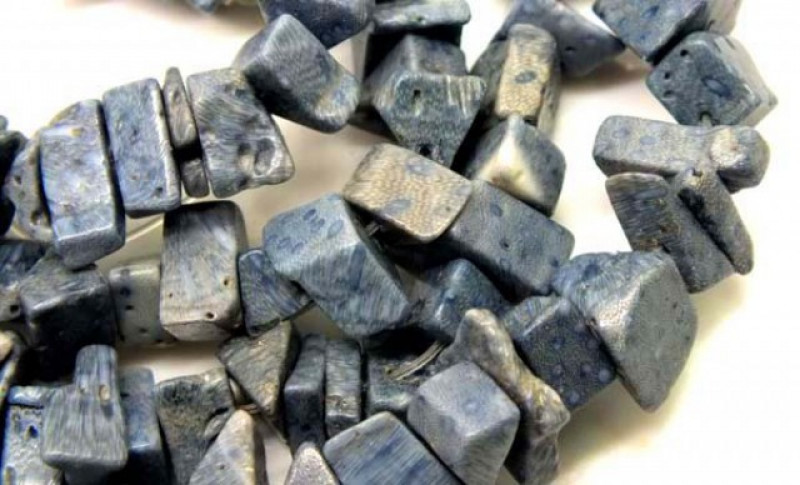
Cut
Most coral stones become cabochons, beads, or carvings. Faceted cuts are rare. The best beads show uniform coloring. Value for carvings depends on the craftsmanship level. Small carvings are popular for earrings or pins. Rough coral may also be fashioned into pendants.
Size
Large, high-quality coral gems are rare and thus, more valuable. Carvers can tinker with lower-quality rough to hide imperfections, so some large carvings are more affordable.
Treatments & Synthetics
Common coral treatments are dyeing, bleaching, surface coating, and impregnation. Coral takes dye well because it’s porous. Usually, pale or white coral gets dyed red or pink. Bleaching is typically done to turn black coral into golden coral.
Jewelers use surface coating or impregnation to improve durability by filling fractures or giving the stone a harder exterior.
Synthetic coral started in the 1970s. Pierre Gilson applied pressure and heat to turn calcite and silica into a coral substitute. You’ll know a coral is synthetic if it lacks a fibrous structure and polyp cavities.

Coral Formation & Sources
Corals have existed since the Cambrian era 535 million years ago. Some of the oldest coral stones are the coral fossils pushed high into mountain ranges from volcanic activity and earthquakes. Often, fossilized coral has portions replaced by agate, creating agatized coral.
The animal itself starts as floating larva. The larvae cling to rocks underwater, often near coasts. Being a pal, the larva secrete calcium carbonate to create a hard structure for other larvae to settle on. The colony slowly reproduces to create coral reefs.
Divers find most coral in shallow, tropical to subtropical ocean waters at least 68℉ (20℃). However, some coral reefs exist in deeper, chillier waters.
With that in mind, where does coral come from?
Harvesting Locations
Most coral gemstone material comes from the Red Sea and the Mediterranean. Indonesia’s coral is known for displaying the most desirable patterns.
Where does red coral come from? The highest-quality red coral comes from the Mediterranean. Lapidarists in Italy and Hong Kong cut most of these stones. Taiwanese and Chinese lapidarists fashion most of the coral from the South China Sea (including oxblood red coral).

Outside the water, fossil coral (image above) is renowned when from Indonesia, where it’s found high in the Barisan Mountains. The only other primary sources for fossil coral are Florida and Georgia, USA.
Other major sources for gem-quality coral are the coasts of:
Australia
Cameroon
Hawaii, USA
Japan
Malaysia
Mauritius
Morocco
Philippines
South Africa
Spain
Taiwan
Now, is coral expensive? It can be, but it depends on its quality and source.

Coral Price & Value
How much is red coral worth? Currently, prices are steep because of high demand from China. The average red coral price right now is $200 per carat, but quality factors mean it ranges from around $10-$250 per carat.
Red coral gemstones without blemishes, under 2 carats is $100 per carat on average. The same stones in 2- to 3-carat sizes average $200 per carat.
Of course, wholesale prices are more affordable. Our red coral cabochons go for $20-$90 per carat. Orange cabochons range from $5-$40 per carat, and white cabochons are $0.20-$3 per carat.
Italian coral carvings cost around $13-$38 per carat. Japanese coral carvings go for $15-$35 per carat. Other coral carvings range from $3-$60 per carat based on color and craftsmanship.
Lastly, small branches of coral rough are only $10-$20 each!
Coral Care and Maintenance
Proper gemstone care is crucial for organic gems like coral. These stones are sensitive to prolonged exposure to light and heat. Plus, blue and dyed coral also fade in color under sunlight.
Many corals are porous, so keep them away from swimming pools and chemicals (including hair and makeup products). Ammonia in particular will harm their polish luster.
Clean your coral with a dry, soft cloth. You can quickly rinse it in lukewarm water, but dry it immediately after. Keep your coral in a soft pouch stored in a cool, dark place.
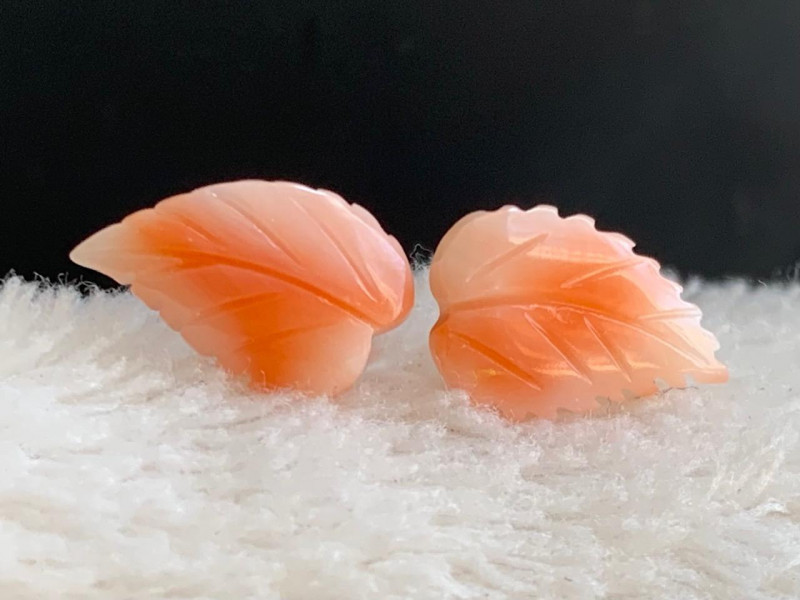
With Coral Gems, The World Is Your Oyster!
Whether you love the ocean, history, or beautiful gemstones, coral has it all. These gorgeous gems can buoy your spirits and keep you grounded, just like coral reefs do for hundreds of creatures. Plus, they serve as a reminder of nature’s beauty.
Quoting Austrian novelist Joseph Roth, “All wear the corals, rich and poor, they raise those below and adorn those above."
Want to make waves in some gorgeous jewelry? Buy coral gemstones today!
Search the Gemstone Encyclopedia
Related Auctions
Related Articles
Originally the Birthstones or gemstones were associated with a zodiac sign or the month of a individuals birth. Find out what your stone is and view the stones we have for sale
8th Feb 2021
There are dozens of quartz and chalcedony gems with various colors and patterns. Learn all about quartz properties and every type of quartz, from amethyst and agate to plasma and phantom quartz!
15th Oct 2020
Hackmanite is a pink to violet sodalite gem known for its unique color-change and luminescence. Learn why hackmanite is special, from its rare qualities to the types of hackmanite jewelry available.
28th Mar 2018
Latest Articles
Tantalite is a group of red, brown, or black minerals containing the rare and valuable element tantalum. Discover the uses, history, prices, and properties of tantalite gemstones in this guide!
11th Nov 2024
Hodgkinsonite is a very rare collector’s gemstone known for its vibrant pink or purple hues, only found in New Jersey, USA. Learn hodgkinsonite’s prices, history, properties, and traits in this guide!
9th Jun 2024
Canasite is a rare mineral usually found as greenish-yellow inclusions in charoite but also known as a purple gemstone. Learn canasite’s history, varieties, properties, and prices in this guide.
27th May 2024
Article Categories
How To's is where you will find helpful articles from gem Rock Auctions on how to cut gemstones, select gemstones and buy gemstones.
9 Articles





